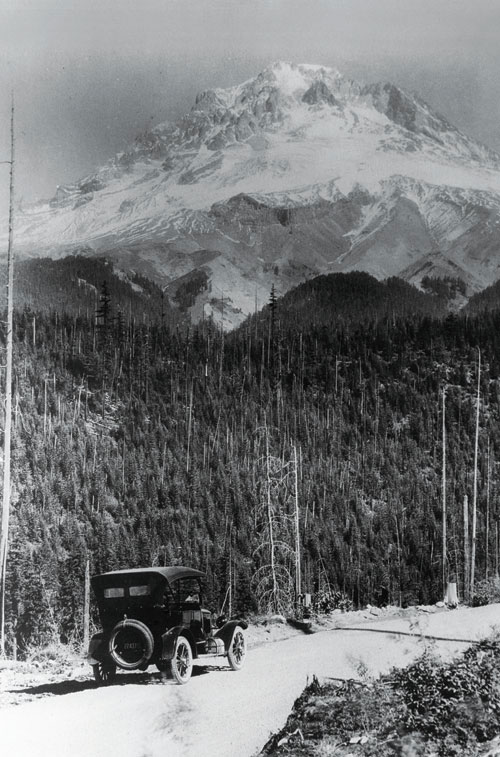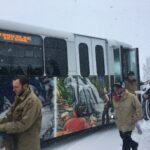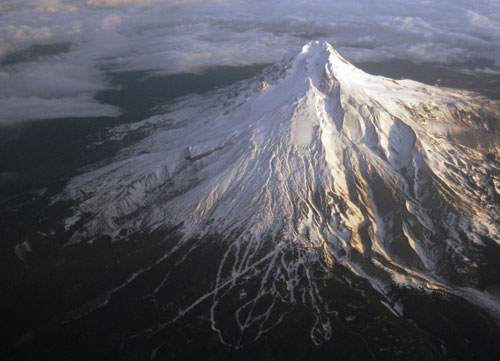 More than 100 years since modern commerce began on Oregon’s signature peak, Mount Hood supports millions of dollars worth of tourism, recreation, agriculture, timber and small business. It’s a unique and massive economy under growing pressure from those who make their money from the mountain.
More than 100 years since modern commerce began on Oregon’s signature peak, Mount Hood supports millions of dollars worth of tourism, recreation, agriculture, timber and small business. It’s a unique and massive economy under growing pressure from those who make their money from the mountain.
By Jon Bell
Two prominent threads have run through John Ingersoll’s life and helped shape who he is today.
The first: summer camp. A Pennsylvania native, Ingersoll has fond memories of summer stints at Camp Kon-O-Kwee, a small, traditional summer camp along the banks of Connoquenessing Creek in western Pennsylvania.
The second: Mount Hood.
Ingersoll first came upon Oregon’s signature mountain during a work sabbatical in 1983. Smitten, he stayed in Oregon, became a certified ski instructor and in 1985 wove those two main threads together by helping to start the National Alpine Ski Camp, a summer ski camp that still operates on Mount  Hood today. He took it a step farther in 1989 when he co-founded one of the mountain’s premier summer snowboard camps, High Cascade Snowboard Camp in Government Camp. Since then — and despite a four-season break from the camp after he sold it to footwear giant Vans Inc. — Ingersoll has primarily made his living on Mount Hood.
Hood today. He took it a step farther in 1989 when he co-founded one of the mountain’s premier summer snowboard camps, High Cascade Snowboard Camp in Government Camp. Since then — and despite a four-season break from the camp after he sold it to footwear giant Vans Inc. — Ingersoll has primarily made his living on Mount Hood.
“It’s just good work,” says Ingersoll, 57, who along with several partners bought High Cascade back from Vans in 2005. “We do good work up here, as most of the camps do. The kids love being up here. It’s pretty rewarding to be around it.”
Today, Hood’s handful of renowned snowboard camps — unique from others across the country because they offer winter terrain in the middle of summer — are big business around the mountain. Windells Camp near Brightwood draws about 1,400 campers every summer and thousands more throughout the year; High Cascade’s six summer sessions bring in close to 1,400 as well. Throw in Mt. Hood Summer Ski Camp and a few other smaller operations, and Ingersoll estimates the yearly revenue from the camps, including tuition and money spent by campers locally, probably ranges from $15 million to $20 million.
“The summer camps are the bread and butter,” Ingersoll says. “It’s a big economic boom.”
The camps are also just one piece of the larger economy that has risen on and around the mountain in the 150 years or so since Samuel Barlow began charging wagons $5 for passage along his namesake road over the mountain and Nathanial Coe planted the first fruit trees in the Hood River Valley. Today, Hood and its surrounding forest is a massive magnet for tourism and recreation; more than 4.5 million people visit the Mount Hood National Forest every year to ski, climb, camp or even just grab a bite to eat at Timberline Lodge.
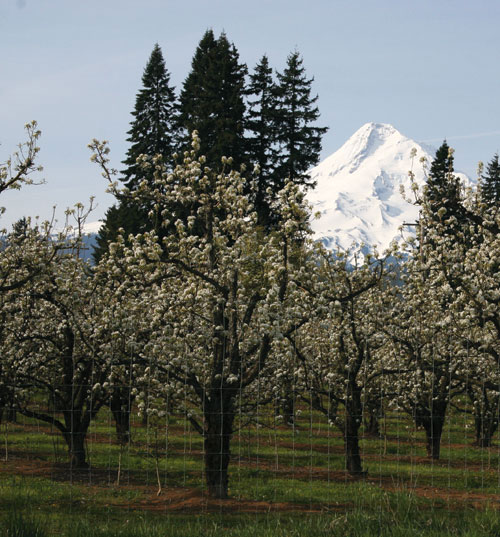 |
Sun and rich volcanic soils help Hood River’s orchards thrive. |
Hundreds of small businesses, from the Wy’east Book Shoppe & Art Gallery in Welches to McIsaac’s Store in Parkdale, tend to the needs of visitors and locals alike. At its seasonal peak, the fruit growing and packing industry in the Hood River Valley employs 3,000 people and harvests crops worth more than $84 million. And though the surrounding forest’s timber output has plunged over the past two decades, some logs do still come from Mount Hood, as do other natural resources, including billions of gallons of water, biomass materials and, potentially, geothermal energy.
“The mountain itself is a big unifying factor in the economy of the region,” says Mary McArthur, executive director of the Mt. Hood Economic Alliance, an economic development partnership that provides small-business loans in Clackamas, Hood River and Wasco counties. “It’s always been a central focus.”
Like any economy, the mountain- and forest-based one around Hood has climbed and slid over the decades. Geographical singularities, seasonal swings and the endless number of people who interact with it every day keep the mountain economy moving. But those same factors can hinder it as well, and as more and more people come to Oregon in the near future and tap into the bounty of the mountain, Mount Hood and its related economy will be faced with a daunting mix of challenge and prosperity.
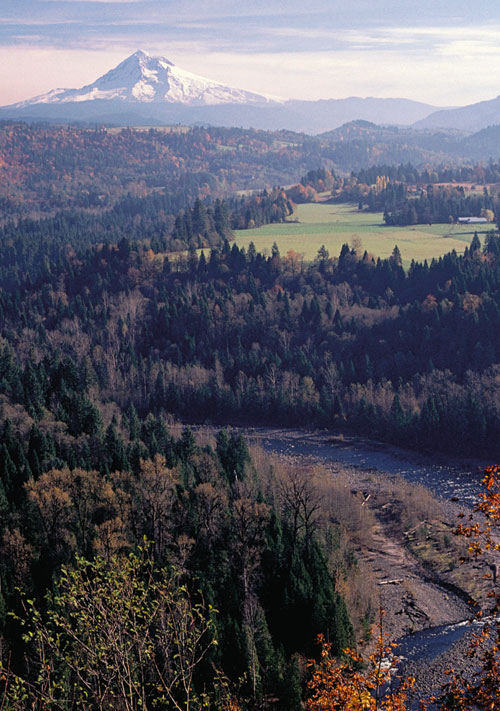 |
Mount Hood is the source for five prominent rivers, including the Sandy River. |
Just over 50 years after the first white explorers caught a glimpse of Mount Hood from the Columbia River, the area’s new locals began heading to the mountain for escape. Early climbers took to its slopes in the mid 1850s — the summit was officially tagged for the first time in 1857 — cross-country skiers sliced the northern reaches of the mountain starting in the 1890s and Summit Ski Area, the oldest ski area in the Pacific Northwest, set up shop in Government Camp in 1927. Post-World War II prosperity brought even more people to the mountain and its forest for everything from camping and fishing to climbing, skiing and, since the mid 1980s, snowboarding.
Today, tourism and recreation are key components to the economy connected to Mount Hood.
“We just have an embarrassment of riches that brings people from all over to Mount Hood,” says Jae Heidenreich, a spokesperson for Oregon’s Mt. Hood Territory, the branded name of the Clackamas County Tourism & Cultural Affairs Department. “It’s a very diverse region with year-round recreation opportunities.”
The 4.5 million visits to the national forest each year include 300,000 campers, 67,000 wilderness users and close to a million skiers at five ski areas around the mountain. According to a travel impacts study by Dean Runyan Associates, direct travel spending by visitors to Mount Hood and the Columbia River Gorge topped $260 million in 2009. Travel spending around the mountain generated $8.7 million in state and local tax receipts, as well.
“Not only do we benefit when our guests come for a day, but so do all the businesses in the corridor between Mount Hood and Portland or wherever else people may be coming from,” says Dave Tragethon, executive director of communications for Mt. Hood Meadows, the mountain’s busiest ski resort with an annual visitor count of between 450,000 and 500,000. Meadows also employs up to 1,000 seasonal employees every year.
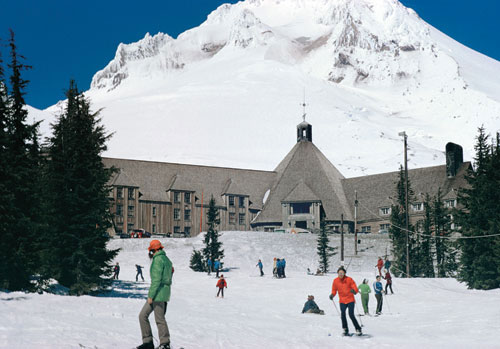 |
In addition to skiers, Timberline may add mountain bikers to its 2 million annual visitors. |
Up at 6,000 feet on the mountain’s south side, Timberline Lodge sees almost 2 million visitors annually, including 350,000 skiers, 40,000 overnight guests and 1.6 million people who just stop by for a visit. To handle that load, R.L.K. and Company, which operates the publicly owned lodge through a special-use permit, employs 300 full-time equivalents with a payroll in excess of $10 million, according to R.L.K. president Jeff Kohnstamm.
“Some of those wages are for temporary jobs, but a lot of them are living wages and it all helps support the local economy,” he says.
The mountain’s recreational pull also helps keep the economy in Hood River sailing along as well. Though the initial spark that rejuvenated the city 25 years ago came primarily from the windsurfing winds of the Columbia River Gorge, Hood River is also the gateway to the mountain’s wild north side and a popular pass-through for skiers heading to the hill. What’s arisen in the 6,000-person town in part as a result of its recreational popularity is a solid and diverse local economy, says Kerry Cobb, president of the Hood River County Chamber of Commerce.
“I think the economy here is really balanced between recreation and agriculture and the services to support those,” she says. “It’s such an interesting combination.”
But Hood River is much more than a hospitality hub. The area’s scenic beauty — Mount Hood one way, Mount Adams the other and the Columbia River front and center — coupled with nearby outdoor recreation opportunities, have been part of what’s attracted and retained strong companies such as Full Sail Brewing, Insitu, Tofurky and DaKine. It’s also given rise to organizations like the Columbia River Gorge Technology Alliance, whose members focus as much on building a strong tech sector in the region as they do on hitting the trails or the river once they’ve punched out for the day.
“The people who move here to windsurf or ski also want to see the right combination of businesses and jobs so that the area can thrive,” Cobb says.
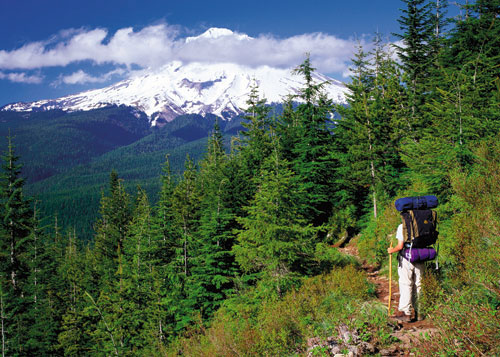 |
Legislation in 2009 designated an additional 127,000 acres of land around Mount Hood as wilderness. |
The economy associated with Oregon’s tallest mountain goes above and beyond recreation and tourism. Ever since Native Americans harvested huckleberries from the mountain’s flanks and pioneers first felled trees for cabins, natural resources from Hood and its surrounding environment have been crucial to not only the region’s economy, but to its very survival.
According to the Forest Service, the nearly 1.1-million-acre MHNF is host to no fewer than 15 municipal watersheds, the largest being the Bull Run Watershed, which provides drinking water for more than 800,000 Oregonians in the Portland metro region. Bull Run’s massive output, which comes not from the mountain’s glaciers but primarily from heavy rainfall, includes water for more than 20,000 commercial, industrial and institutional users such as Wacker Siltronic, Precision Castparts and Vigor Industrial.
Water from the Hood River, which pours directly off the mountain’s east and northern faces, also helps irrigate the pear, apple and cherry orchards of the Hood River Valley, one of the economic foundations of the area.
“Agriculture is the No. 1 economic factor in Hood River County and it has been forever,” says Jean Godfrey, executive director of the Columbia Gorge Fruit Growers, a nonprofit organization that works on behalf of growers and shippers in the mid-Columbia area. “Some people like to think it’s tourism, but it’s not.”
Every year, 350 growers in the Hood River Valley produce about 196,000 tons of pears, apples and cherries. When harvest is in full swing, more than 3,000 people are at work in orchards and packing houses across the valley. And once the picking and packing is done, roughly $84 million worth of fruit ships out, 30% of it leaving the country and the rest finding its way across it.
Another key natural resource, one which used to underpin much of the mountain economy, plays a fraction of the role that it used to: timber.
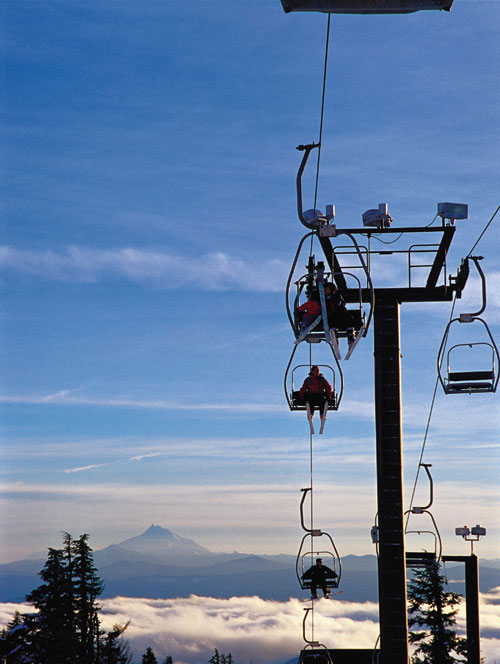 |
Mount Hood boasts the longest ski season in North America. |
In the 1920s, loggers harvested about 25 million board feet of timber from the Mount Hood National Forest every year. Between 1958 and 1988, the average annual harvest hovered around 300 million board feet. But economic declines and, ultimately, lawsuits in the late 1980s and early 1990s over habitat protection for endangered species like the spotted owl cut the forest’s output to a mere fraction of what it once had been. The allowable cut is now set at 64 million board feet, a number the Forest Service rarely attains.
According to Rick Acosta, a public affairs officer for the MHNF, 36 million board feet with an appraised value of $1.7 million were cut from the forest in 2010. Most of it fell under the Forest Service’s Stewardship Contract Authority, which allots a portion of timber sale receipts — $330,000 last year — for improving fish habitat and other restoration projects.
Further trimming the forest’s commercial timber output — or eliminating it altogether — would be just fine with some conservation groups, who would rather see the MHNF managed for its recreational and environmental resources.
“If there were any forest in the country that could have a management plan that is focused entirely on providing recreation opportunities and protecting ecosystems for things like clean water and carbon storage, Mount Hood would be it,” says Alex P. Brown, executive director of the Mount Hood conservation group Bark.
Others, however, say there’s room — and demand — to increase the forest’s timber output.
Bill Wilkins co-owns Mt. Hood Forest Products, a sawmill just south of Hood River that employs 45 people and produces about 80 million board feet of housing lumber every year. About 2% of his logs come from the national forest; the rest come from private lands or some other form of government land. Before the spotted owl suits, he says, the ratio was almost the exact opposite.
“In our opinion, we went from a managed forest to a completely unmanaged one,” says Wilkins, who also co-owns mills in Washington and has been in the business for nearly 40 years. “It’s gone way too far the other way.”
The drop in housing starts has hit the wood products industry hard, and Wilkins says an overall shortage of logs combined with Chinese competition for logs from private land has compounded the situation. Though he doesn’t foresee any uptick in the harvest in the MHNF any time soon — the Forest Service has no plans for it either — he says an increase would be a boon to the local economy.
“We would love to see a reasonable amount of harvest,” Wilkins says. “We only run one shift here right now, but if people started building houses again and the logs were available, there’s no reason we wouldn’t add a second one.”
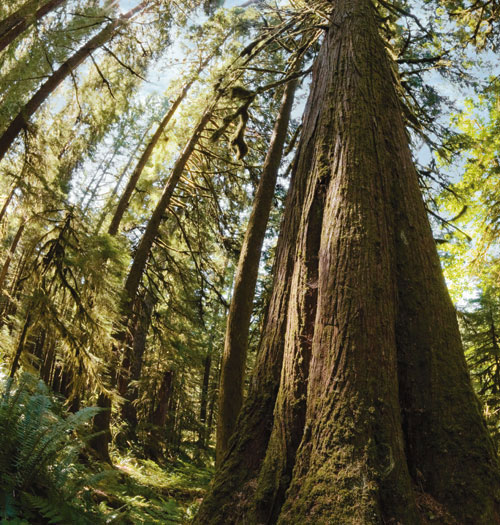 |
Mount Hood National Forest once provided more than 300 million board feet of timber every year. |
Although logging’s demand on the forest surrounding Mount Hood has dropped off precipitously, few other pressures have or will anytime soon.
For starters, the Portland metro area’s population is expected to nearly double to 3.8 million people by 2060. Similarly, Government Camp as it exists today could be an entirely new place in the not too distant future. After a coalition of Hood River Valley residents and environmental groups blocked Mt. Hood Meadows’ proposed resort on the north side of Hood in 2004, an agreement tentatively traded 700 acres of Meadows’ property on the north side for 120 acres of developable land in Government Camp. If the Forest Service approves the land swap — and if the economy eventually warms back up — Government Camp, an unincorporated village of about 135 registered voters, could see a wave of new residential development.
In addition, Timberline Lodge has proposed a lift-assisted mountain bike park, which would provide a sanctioned area for riding. Portland General Electric and other utility companies have expressed interest in exploring areas of the MHNF for geothermal energy sources. Ten thousand people already try to climb Mount Hood every year.
More people visiting the mountain will likely mean more revenue for small businesses like Joe’s Doughnut Shop in Sandy and more hotel tax dollars for county services and tourism efforts around the mountain. More people living or vacationing in Government Camp would certainly spur new retail and commercial endeavors.
But more people and greater demands will do more than stimulate the surrounding economy. They will use more water. They will clog the roads, the campgrounds and trailheads; they will create longer lift lines and fill parking lots at places like Timberline and Meadows, which already turn people away on busy days. Kohnstamm and others have long lobbied for improvements to the transportation system around the mountain — wider roads, mass transportation, possibly even an aerial tram — in vain.
“We’ve always suffered from underfinanced and under planned transportation systems,” he says. “That, I think, is the biggest challenge facing the mountain today.”
Fixing the transportation system around the mountain would not, of course, come cheap. And not only is there little funding available for major upgrades, but the money that may be in the state’s budget often gets allocated to projects in more populated areas. That’s an issue that has long plagued — and united — businesses out in the rural shadows of the mountain.
“I think there is still a little sensitivity toward the Metro area in terms of its political clout,” says McArthur, of the Mt. Hood Economic Alliance. “Rural communities still have to pay for infrastructure upgrades, but how do you fund those when your rate base is not large but you have a user base that is?”
That’s the kind of economic paradox that is likely to continue creating tension around the mountain into the future as more people come to the region, escape to the mountain and rely on its resources. The mountain’s wild beauty and its magnetic pull are at once its greatest attributes and its greatest perils. Were it not the grand mountain that it is, if it did not have its iconic profile, its historic lodge and lingering ski season, its towering forests, crystalline waters and rich volcanic soils, there would be no 4.5 million visitors spending hundreds of millions of dollars here every year, no orchard industry, no snowboard camps.
And yet, the more people who come to the area to live or even visit, the more the mountain and its resources are taxed. Timberline’s mountain bike park, for example, could generate an estimated $1 million in visitor spending every year, which would boost the local economy. But conservation groups oppose it, citing potential environmental damage and increased traffic and noise at the lodge. Similar tensions will likely arise whenever new development or transportation upgrades visit the mountain as well.
For more than 100 years now, Mount Hood’s recreation, tourism, agriculture and natural resources have coalesced into a unique economy tied directly to the mountain and its surrounding environment. It is an economy that has a reach far beyond the mountain itself, from the Bull Run water serving the Oregon Zoo — and its 1.5 million annual visitors — to the Hood River pears that end up in Russia and Taiwan and the international snowboarding teams that practice at Timberline in the summer. It is an economy challenged by weather, geography and the tenuous balance between growth and conservation, extraction and preservation. And it is an economy — and a mountain — that will continue to shape and texture an entire region.
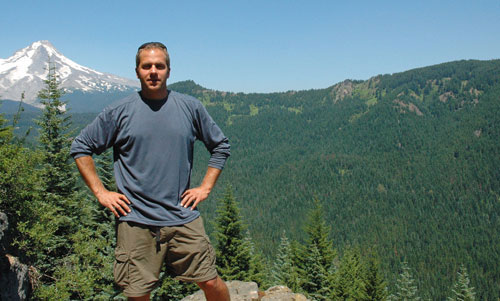 About the author: An Ohio native, Jon Bell had never seen Mount Hood until he moved to Oregon in 1997. Once he did, however, he quickly found himself drawn to the mountain. Since then he’s climbed it, hiked it, camped on it, kind of learned to ski on it and otherwise become acquainted with the state’s signature peak. “Everyone I know out here has some kind of a connection with Mount Hood,” he says, “It has such a huge presence and influence.” A graduate of Michigan State University, Bell is a regular contributor to Oregon Business. His work has also
About the author: An Ohio native, Jon Bell had never seen Mount Hood until he moved to Oregon in 1997. Once he did, however, he quickly found himself drawn to the mountain. Since then he’s climbed it, hiked it, camped on it, kind of learned to ski on it and otherwise become acquainted with the state’s signature peak. “Everyone I know out here has some kind of a connection with Mount Hood,” he says, “It has such a huge presence and influence.” A graduate of Michigan State University, Bell is a regular contributor to Oregon Business. His work has also 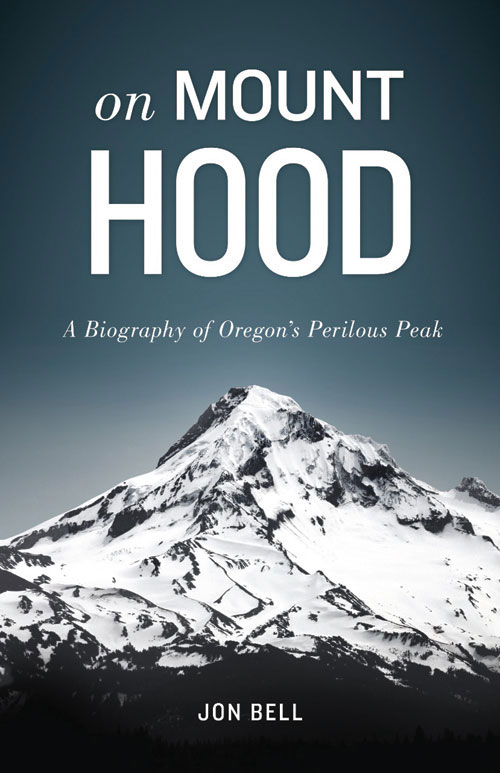 appeared in publications such as Backpacker, The Oregonian and Oregon Coast. His book, On Mount Hood (Sasquatch Books, $22.95) is out this month.
appeared in publications such as Backpacker, The Oregonian and Oregon Coast. His book, On Mount Hood (Sasquatch Books, $22.95) is out this month.
Jon Bell will be a guest June 10 on OPB Radio’s Think Out Loud as part of their “Mt. Hood Inc.” series. It will broadcast in front of a live audience at Timberline Lodge from 9-10 a.m.
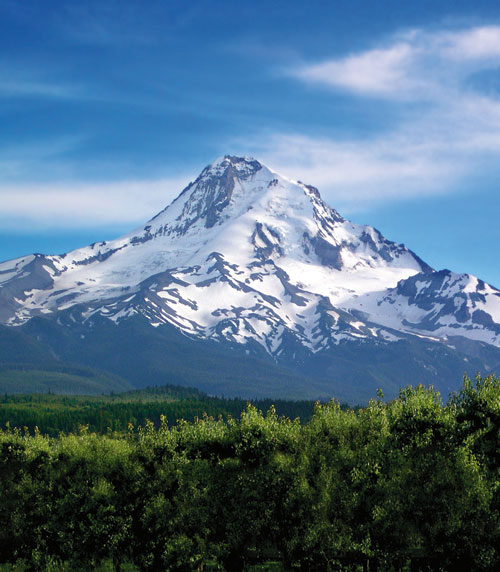
- Before awarding Richard Kohnstamm the permit to operate Timberline Lodge in 1955, the Forest Service considered burning the rundown and mismanaged lodge to the ground.
- Hood’s 11 glaciers have lost one-third to half their volume since the turn of the 20th century.
- A storied collie from Government Camp named Ranger climbed the mountain more than 500 times in his life and was buried on the summit after he died in 1939.
- Mount Hood is the fourth-most-dangerous volvano in the U.S. based on size and potential damage of an eruption, according to the United States Geological Survey.
- Mount Hood is home to the oldest ski patrol-the Mount Hood Ski Patrol-and the oldest mountain search and rescue organization-the Crag Rats-in the country.
- Since 1920, flooding and glacial outbursts have washed out or forced the closure of Highway 35 on Hood’s east side no fewer than 20 times.
- The snowcat and the releasable ski binding both trace their origins to the slopes of Mount Hood.
- To date, every U.S. Olympic snowboarder to win a medal, including Shaun White, has trained on Mount Hood at Windells Camp.
- Area Native Americans of the Multnomah tribe are called Mount Hood Wy’east.
Mount Hood timeline
500,000-700,000 years ago Eruptions begin building the Mount Hood that we know today.
100,000 years ago Hood’s north side collapses, unleashing a massive avalanche that temporarily dams the Columbia River.
1781 Hood’s most recent eruption sends volcanic mudflows down the mountain and leaves in its wake the lava dome known as Crater Rock.
1792 White explorers first see the mountain and William Broughton, a British naval officer and member of George Vancouver’s exploration party, names it after Lord Samuel Hood.
1805 Lewis and Clark come across a river choked with debris from Hood’s eruption and call it the Quicksand River — today’s Sandy River.
1846 Samuel Barlow and Philip Foster build the Barlow Road from Hood’s east side over its southern pass to Oregon City.
1857 A team led by Henry Pittock, future owner of The Oregonian, nabs the first recorded summit of Mount Hood.
1892 President Benjamin Harrison protects the Bull Run Watershed in the northwest shadow of Hood. Today, it provides water to more than 800,000 Oregonians.
1889 Portland banker William Ladd and attorney C.E.S. Wood build and open Cloud Cap Inn at 6,000 feet on the north side of the mountain.
1919 Severe freeze decimates apple trees in Hood River Valley, prompting growers to switch to heartier pears.
1927 Summit Ski Area in Government Camp, the oldest ski area in the Pacific Northwest, opens its slopes.
1937 President Roosevelt dedicates the $1 million Timberline Lodge, which was built in just 15 months.
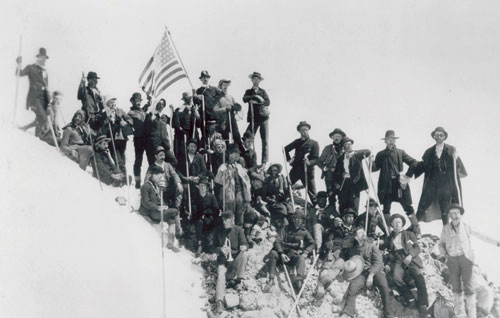 1966 Forest Service angers Hood River residents when it awards a permit for a new ski area to Portland builder Franklin Drake, who opens Mt Hood Meadows the next year.
1966 Forest Service angers Hood River residents when it awards a permit for a new ski area to Portland builder Franklin Drake, who opens Mt Hood Meadows the next year.
1978 Stanley Kubrick shoots minor outside footage of Timberline for use in The Shining.
1986 Seven students and two faculty members of the Oregon Episcopal School are killed in the mountain’s worst climbing accident.
1988 Logging in the Mount Hood National Forest hits close to 400 million board feet and begins a steep decline. In 2010, 36 million board feet are harvested.
1991 City of Portland adds two new vista corridors downtown, which prevent new buildings from interfering with views of Mount Hood.
1999 Widespread opposition prompts Forest Service to nix proposal to limit South Side climbers to 25 per day. An estimated 10,000 climbers attempt to summit each year.
2002 An Air Force Pave Hawk helicopter evacuating an injured climber crashes and barrel-rolls 800 feet down the mountain. Everyone on board survives.
2004 Meadows scraps its controversial plan for a 450-home resort on the mountain’s north side in favor of a swap for developable land in Government Camp.
2010 Annual visits to the Mount Hood National Forest top 4.5 million.

